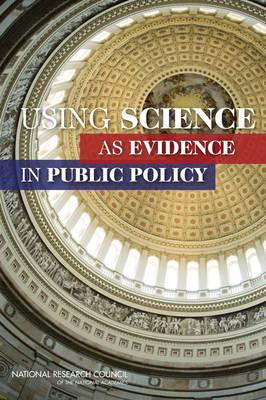Using Science as Evidence in Public Policy encourages scientists to think differently about the use of scientific evidence in policy making. This report investigates why scientific evidence is important to policy making and argues that an extensive body of research on knowledge utilization has not led to any widely accepted explanation of what it means to use science in public policy. Using Science as Evidence in Public Policy identifies the gaps in our understanding and develops a framework for a new field of research to fill those gaps. For social scientists in a number of specialized fields, whether established scholars or Ph.D. students, Using Science as Evidence in Public Policy shows how to bring their expertise to bear on the study of using science to inform public policy. More generally, this report will be of special interest to scientists who want to see their research used in policy making, offering guidance on what is required beyond producing quality research, beyond translating results into more understandable terms, and beyond brokering the results through intermediaries, such as think tanks, lobbyists, and advocacy groups. For administrators and faculty in public policy programs and schools, Using Science as Evidence in Public Policy identifies critical elements of instruction that will better equip graduates to promote the use of science in policy making. Table of ContentsFront MatterSummary1 Introduction2 Why This Report Now3 The Use of Research Knowledge: Current Scholarship4 Research on the Use of Science in Policy: A Framework5 The Next Generation of Researchers and PractitionersReferencesAppendix A: Selected Major Social Science Research Methods: OverviewAppendix B: Biographical Sketches of Committee Members and Staff
Using Science as Evidence in Public Policy encourages scientists to think differently about the use of scientific evidence in policy making. This report investigates why scientific evidence is important to policy making and argues that an extensive body of research on knowledge utilization has not led to any widely accepted explanation of what it means to use science in public policy. Using Science as Evidence in Public Policy identifies the gaps in our understanding and develops a framework for a new field of research to fill those gaps.
For social scientists in a number of specialized fields, whether established scholars or Ph.D. students, Using Science as Evidence in Public Policy shows how to bring their expertise to bear on the study of using science to inform public policy. More generally, this report will be of special interest to scientists who want to see their research used in policy making, offering guidance on what is required beyond producing quality research, beyond translating results into more understandable terms, and beyond brokering the results through intermediaries, such as think tanks, lobbyists, and advocacy groups. For administrators and faculty in public policy programs and schools, Using Science as Evidence in Public Policy identifies critical elements of instruction that will better equip graduates to promote the use of science in policy making.
Get Using Science as Evidence in Public Policy by at the best price and quality guranteed only at Werezi Africa largest book ecommerce store. The book was published by National Academies Press and it has pages. Enjoy Shopping Best Offers & Deals on books Online from Werezi - Receive at your doorstep - Fast Delivery - Secure mode of Payment
 Jacket, Women
Jacket, Women
 Woolend Jacket
Woolend Jacket
 Western denim
Western denim
 Mini Dresss
Mini Dresss
 Jacket, Women
Jacket, Women
 Woolend Jacket
Woolend Jacket
 Western denim
Western denim
 Mini Dresss
Mini Dresss
 Jacket, Women
Jacket, Women
 Woolend Jacket
Woolend Jacket
 Western denim
Western denim
 Mini Dresss
Mini Dresss
 Jacket, Women
Jacket, Women
 Woolend Jacket
Woolend Jacket
 Western denim
Western denim
 Mini Dresss
Mini Dresss
 Jacket, Women
Jacket, Women
 Woolend Jacket
Woolend Jacket
 Western denim
Western denim
 Mini Dresss
Mini Dresss






























































